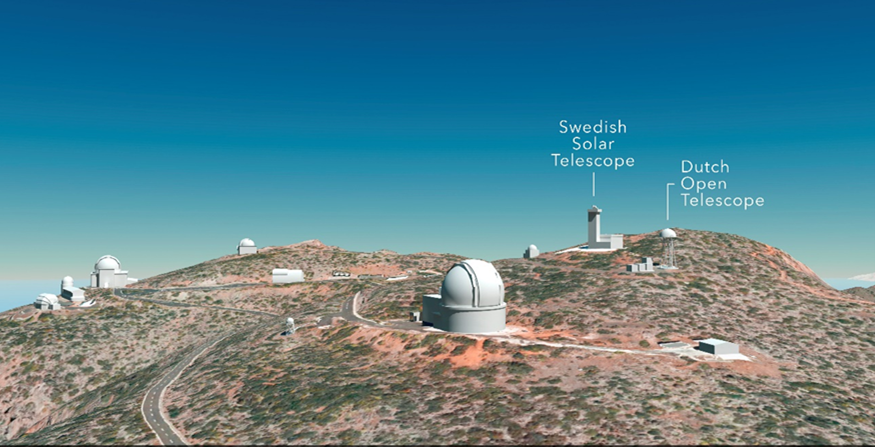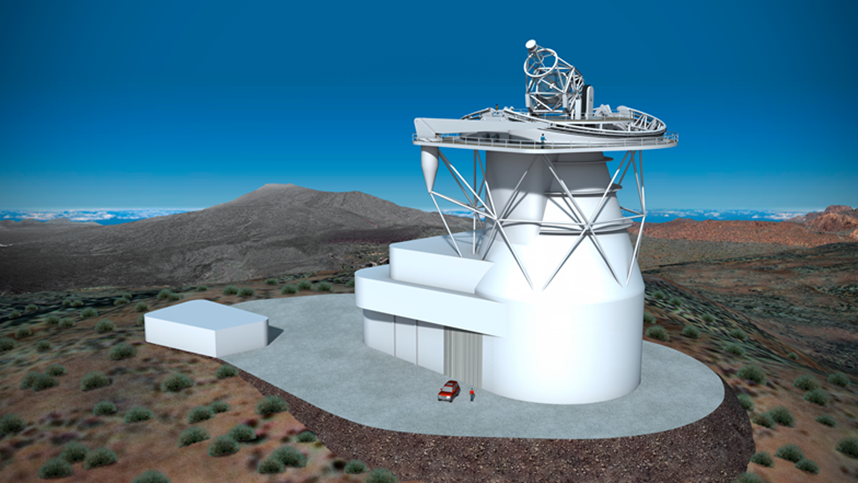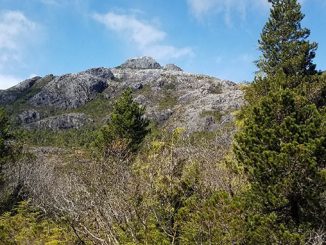
Undeterred by a massive volcanic eruption on the island of La Palma in the Canary Islands, scientists are proceeding with their plans to build the European Solar Telescope there in pursuit of learning more about the mysteries of magnetic coupling in the sun’s atmosphere. A massive eruption of the Cumbre Vieja volcano on the northeast Atlantic island in September spurred evacuations, injected gases and ash high into the sky, lasting about two months and emitting a flow of lava that stretched miles to the sea. It was the first on-land volcanic eruption in the islands in fifty years.
A part of Spain and home to more than 80,000 people as well as other volcanic sites, La Palma is also home to a collection of observatories, located there for the island’s attributes as a prized site for peering deep into space. Only four months before the eruption, it was approved to install the new telescope at Roque de los Muchachos Observatory, shown in the center of the image above, near the Dutch Open Telescope and the Swedish Solar Telescope. (Image credit: Gabriel Pérez, IAC)
“The recent volcanic eruption on La Palma has not affected the observatory in any way,” according to Luis Bellot, EST Communications Head, with the Instituto de Astrofísica de Andalucía. Responding to an inquiry from Magnetics Magazine about the status of the project, he explained: “Indeed, it is located on the northern part of the island, far from the hot spot in the south. Therefore, the EST project still plans to start the construction of the telescope at the Roque de Los Muchachos Observatory, as one of the best locations worldwide for solar observations.”

A next generation large-aperture solar telescope with a 4.2-metre primary mirror, the telescope will be optimized for studies of the magnetic coupling of the solar atmosphere. EST will specialise in high spatial and temporal resolution, using several instruments simultaneously to efficiently produce 2D spectral information to reveal the intricate patterns of the magnetic fields and the complex dynamics of a stellar atmosphere.
Solar magnetic activity can affect millions of people on short and long-time scales. Scientists want to predict disturbances of the space environment induced by the Sun and to understand the links between the solar output and the Earth’s climate. Since all stars are suns, this star is a fundamental model for understanding the rest of the universe and the only one that can be studied in high resolution.

In addition to spatial resolution, the light collecting power of a large aperture is crucial for solar investigations. Magnetic fields are detected and characterized by analysing their imprint on the polarisation of light in suitably chosen spectral lines. The accuracy achieved in these polarimetric measurements and the ability to observe magnetic fields is limited by the number of photons collected. With a large aperture, a greater number of photons can be detected in any given zone on the surface of the sun. Since EST is aimed at obtaining diffraction-limited images, it must be located at a site where atmospheric turbulence above the telescope is minimized, leading to the reputation of the Canary Islands as a premier site for solar observations. For more info, see www.est-east.eu.



